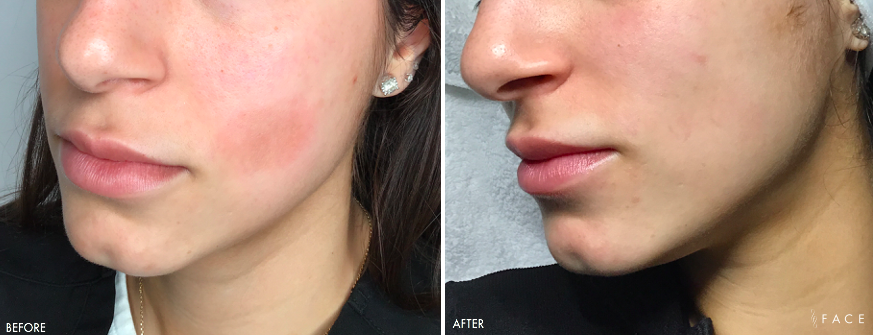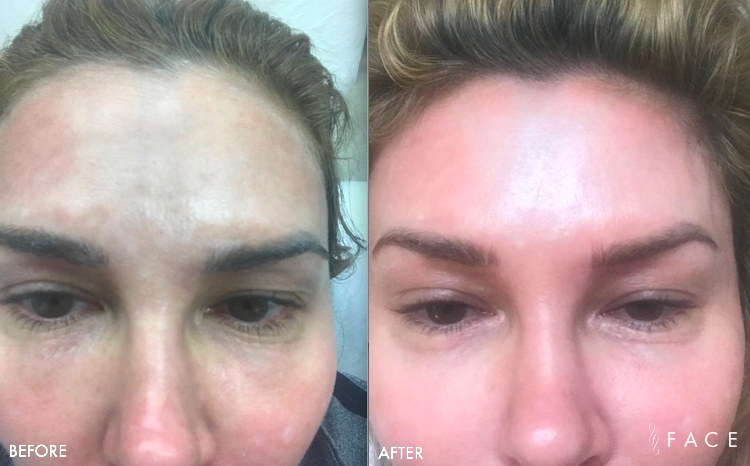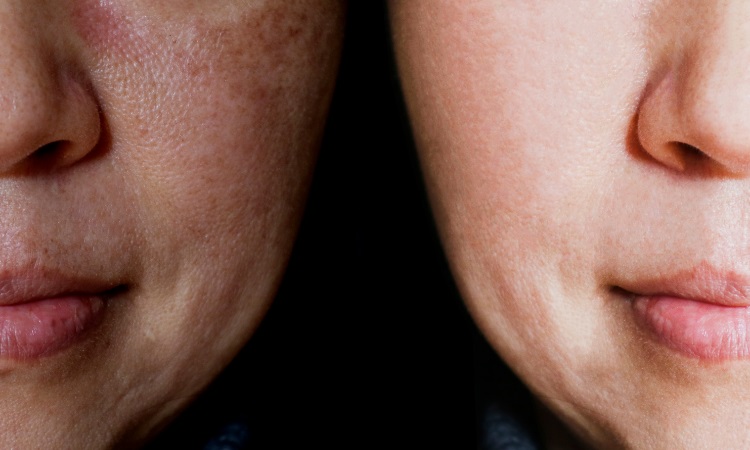How to Treat Hyperpigmentation
At FACE Skincare~Medical~Wellness, our skin management experts will work with you to find the best treatment for you. Treating hyperpigmentation may involve targeting the pigment molecules to remove them. Treatment can also remove or restore the outer layers of skin to remove excessive pigment. Many of these methods have other anti-aging and skin-improving benefits. Some available treatment options include:
Chemical Peels
Highly customizable chemical peels reveal new layers of skin that look clearer and healthier. Some chemical peels, such as the Vi Peel, or Enlighten peel, precisely target hyperpigmentation and skin clarity. Chemical peels vary in strength, so we will customize your peel to address your needs.
Effective Skincare Ingredients for Hyperpigmentation
Targeting Hyperpigmentation with Skincare
Certain skincare ingredients are known to reduce hyperpigmentation. Incorporating these into your routine can help lighten dark spots and even out skin tone.
Vitamin C
Vitamin C is a powerful antioxidant that brightens the skin and reduces the appearance of dark spots. It works by inhibiting melanin production, which helps fade existing pigmentation over time. Look for serums or creams with a stable form of vitamin C for the best results.
Retinoids
Retinoids, including retinol, are derived from vitamin A and are highly effective in treating hyperpigmentation. They speed up cell turnover, helping to shed pigmented skin cells and reveal new, healthy skin underneath. Regular use can lead to a more even complexion.
Alpha Hydroxy Acids (AHAs)
AHAs, such as glycolic acid and lactic acid, exfoliate the skin’s surface. This exfoliation removes dead skin cells, making way for new skin cells. Over time, this can reduce the appearance of dark spots and improve skin texture.
Niacinamide
Niacinamide, also known as vitamin B3, is another ingredient that can help with hyperpigmentation. It reduces the transfer of melanin to the skin’s surface, leading to a more even skin tone. It’s also known for its anti-inflammatory properties, making it suitable for sensitive skin.
Kojic Acid
Kojic acid is a natural ingredient that inhibits the production of tyrosine, an amino acid needed for melanin production. This makes it effective in lightening dark spots and treating hyperpigmentation.
Using these ingredients in your skincare routine can gradually lighten hyperpigmentation and prevent new spots from forming.
Microneedling
Radiofrequency (RF) microneedling offers an excellent option for overall skin rejuvenation. Needles create tiny channels in the skin while delivering pulses of RF energy. Microneedling breaks up hyperpigmentation and brings healthy new cells to the surface.
Laser Treatments
Laser treatments range from very gentle to intensive. To dramatically remove pigment quickly, you may want a CO2 or Erbium laser like Halo, Pearl, or Total FX. If you have more moderate to minor pigmentation concerns or cannot afford to take any time off, less intensive laser treatments like Moxi, Clear and Brilliant, or Permea, may work better. If you have hyperpigmentation, we offer one of the largest selection of lasers to meet your needs.
BBL And IPL
BBL or IPL, types of energy devices that use Broad Band Light or Intense Pulsed Light, to quickly target problem pigment on lighter skin types. Post treatment you will see slightly darker brown spots for 7-10 days which flake off to reveal brighter more youthful skin. These treatments are not indicated for Melasma.
Pico Laser
Pico lasers are an extremely effective way to remove pigment, similar to how a tattoo is removed. With virtually no downtime, safe on all ethnicities, and summer-friendly, this can effectively remove sun damage, melasma, and other pigment from the face.
Advanced Treatment Options for Hyperpigmentation
Comparing Treatment Options
When home remedies and skincare products aren’t enough, advanced treatments can provide more significant results. Here’s a look at some effective options:
Laser Treatments
Laser treatments are one of the most effective ways to treat hyperpigmentation. They target pigmented cells deep within the skin without damaging the surface. Treatments like CO2 lasers or fractional lasers break down excess melanin, leading to a more even skin tone. However, the intensity of the treatment can vary, so consultation with a dermatologist is essential.
Chemical Peels
Chemical peels involve applying a solution that exfoliates the outer layers of skin, revealing the fresher, less pigmented skin beneath. Peels can range from mild to deep, depending on the severity of the pigmentation. Mild peels have little to no downtime, while deeper peels may require recovery time but offer more dramatic results.
Microneedling
Microneedling uses tiny needles to create controlled injuries in the skin. This process stimulates collagen production and accelerates skin cell turnover, which helps fade dark spots over time. It’s a good option for those with mild to moderate hyperpigmentation and can be combined with other treatments for better results.
BBL and IPL
Broad Band Light (BBL) and Intense Pulsed Light (IPL) treatments are non-invasive options that use light energy to target and break down pigmented cells. These treatments are particularly effective for lighter skin types and can address a range of pigmentation issues with minimal downtime.
Pico Laser
Pico lasers are highly effective in treating hyperpigmentation, particularly stubborn cases like melasma. These lasers work by delivering ultra-short pulses of energy to break down the pigment into tiny particles, which the body then naturally eliminates. Pico lasers are safe for all skin types and typically require little to no downtime.
Each treatment has its pros and cons, and the best option depends on the type and severity of your hyperpigmentation. Consulting with a dermatologist will help determine the most suitable approach for your skin.
Cryotherapy
We offer the Glacial Rx, which uses cold instead of heat energy, to down-regulate pigmentation . We also provide a variety of facials and exfoliation treatments.










